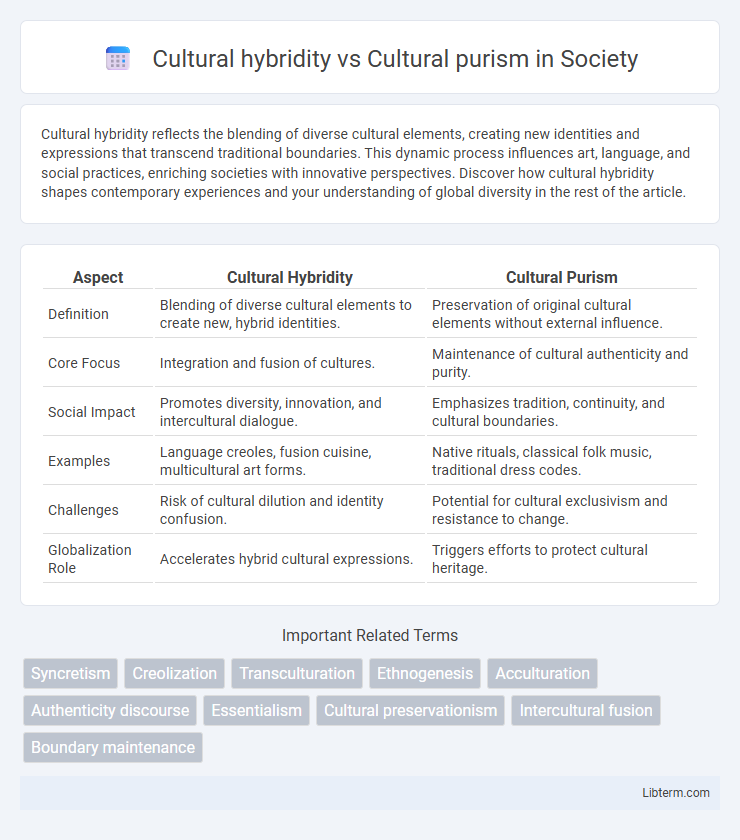Cultural hybridity reflects the blending of diverse cultural elements, creating new identities and expressions that transcend traditional boundaries. This dynamic process influences art, language, and social practices, enriching societies with innovative perspectives. Discover how cultural hybridity shapes contemporary experiences and your understanding of global diversity in the rest of the article.
Table of Comparison
| Aspect | Cultural Hybridity | Cultural Purism |
|---|---|---|
| Definition | Blending of diverse cultural elements to create new, hybrid identities. | Preservation of original cultural elements without external influence. |
| Core Focus | Integration and fusion of cultures. | Maintenance of cultural authenticity and purity. |
| Social Impact | Promotes diversity, innovation, and intercultural dialogue. | Emphasizes tradition, continuity, and cultural boundaries. |
| Examples | Language creoles, fusion cuisine, multicultural art forms. | Native rituals, classical folk music, traditional dress codes. |
| Challenges | Risk of cultural dilution and identity confusion. | Potential for cultural exclusivism and resistance to change. |
| Globalization Role | Accelerates hybrid cultural expressions. | Triggers efforts to protect cultural heritage. |
Understanding Cultural Hybridity
Cultural hybridity refers to the dynamic process where different cultural elements merge, creating new, syncretic identities and practices that transcend traditional boundaries. Understanding cultural hybridity involves recognizing the fluidity and negotiation of identities shaped by globalization, migration, and media, which challenge the notion of fixed, homogeneous cultures. This concept highlights how cultural exchange fosters innovation and diversity, contrasting with cultural purism's emphasis on preserving perceived authentic and unaltered cultural forms.
Defining Cultural Purism
Cultural purism emphasizes preserving a culture's original elements by resisting external influences and maintaining traditional practices, languages, and values in their authentic form. It advocates for safeguarding cultural identity through strict adherence to established customs, often rejecting hybrid or blended cultural expressions. This approach contrasts with cultural hybridity, which embraces the fusion and evolution of cultures through interaction and exchange.
Historical Roots of Cultural Hybridity
Historical roots of cultural hybridity trace back to ancient trade routes, such as the Silk Road, where diverse civilizations exchanged goods, ideas, and customs, fostering blended cultural identities. Colonial encounters further accelerated hybridity by imposing and intermingling languages, religions, and social practices, leading to syncretic traditions. This dynamic contrasts with cultural purism, which seeks to preserve an unaltered, homogeneous cultural identity by resisting external influences.
Origins and Motivations Behind Cultural Purism
Cultural purism originates from a desire to preserve and protect traditional customs, languages, and values perceived as authentic and endangered due to globalization and external influences. Motivations behind cultural purism often include safeguarding national identity, resisting cultural dilution, and maintaining social cohesion within a specific community. Purists advocate for strict adherence to ancestral heritage to prevent the loss of cultural distinctiveness in an increasingly interconnected world.
The Impact of Globalization on Cultural Exchange
Globalization accelerates cultural hybridity by fostering interaction and blending of diverse traditions, languages, and practices, resulting in innovative cultural expressions and enhanced social cohesion. Cultural purism resists this integration, emphasizing the preservation of distinct cultural identities and traditional values to maintain historical continuity and authenticity. The tension between hybridity and purism shapes cultural exchange dynamics, influencing policies on multiculturalism, identity politics, and globalization's role in cultural transformation.
Identity Formation in Hybrid vs Purist Contexts
Cultural hybridity fosters identity formation through the blending of diverse traditions, languages, and values, creating dynamic and fluid self-concepts that reflect multiple cultural influences. In contrast, cultural purism emphasizes preserving a singular, unaltered heritage, promoting identity formation rooted in historical continuity and collective memory. Hybrid contexts encourage adaptability and pluralism in identity, while purist contexts prioritize stability and exclusivity in cultural belonging.
Sociopolitical Implications of Hybrid and Pure Cultures
Cultural hybridity fosters sociopolitical inclusivity by blending diverse traditions, promoting dialogue, and challenging rigid identity boundaries, which can enhance social cohesion and adaptability in multicultural societies. In contrast, cultural purism often underpins exclusionary nationalist movements, reinforcing ethnonationalist ideologies that marginalize minority groups and intensify sociopolitical conflicts. The tension between hybrid and pure cultural models reflects broader struggles over identity, power, and governance in globalized contexts, influencing policies on immigration, education, and social integration.
Challenges and Criticisms of Cultural Hybridity
Cultural hybridity faces challenges including identity conflicts, cultural appropriation, and dilution of traditional values, as it blends diverse cultural elements into new forms. Critics argue that hybridity risks erasing authentic cultural heritage by promoting superficial or commodified representations. This dynamic often sparks debates about power imbalances and the authenticity of hybrid cultural expressions in globalized societies.
Debates Surrounding Cultural Purism in Modern Societies
Debates surrounding cultural purism in modern societies revolve around the tension between preserving traditional cultural identities and embracing cultural hybridity, where diverse influences merge to create new, dynamic forms. Critics of cultural purism argue it fosters exclusion and stagnation by resisting intercultural exchange, while proponents emphasize the importance of safeguarding heritage and authentic practices amid globalization. Sociologists and anthropologists highlight that cultural hybridity often reflects socio-political realities, challenging rigid boundaries imposed by purist ideologies.
Navigating the Future: Integration or Separation?
Cultural hybridity fosters dynamic integration by blending traditions and innovations, promoting adaptability in a globalized world, whereas cultural purism emphasizes preserving distinct identities through separation to maintain historical authenticity. Navigating the future requires balancing intercultural exchange and boundary maintenance to ensure both diversity and cohesion. Policy frameworks and social practices must address the tension between embracing multicultural influences and safeguarding cultural heritage for sustainable coexistence.
Cultural hybridity Infographic

 libterm.com
libterm.com